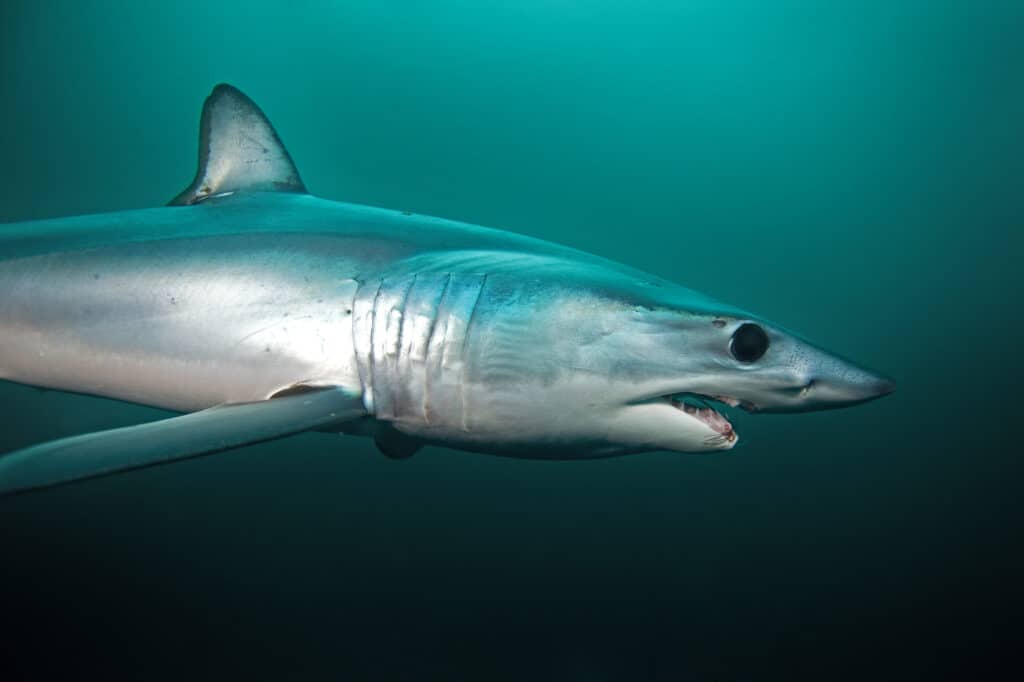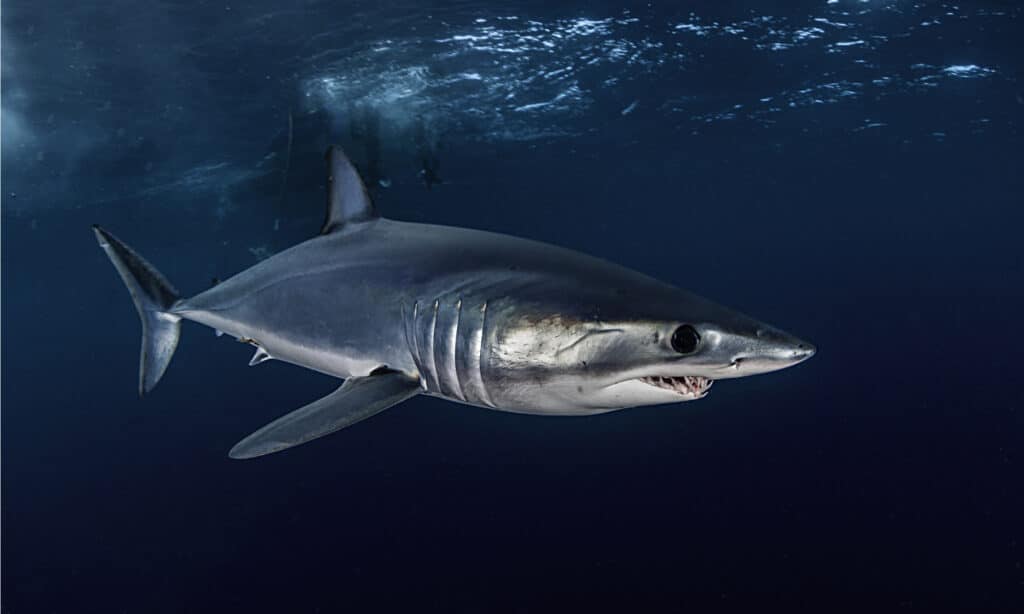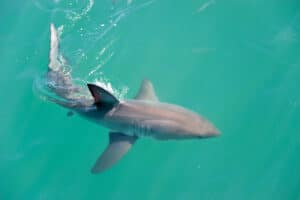The two living species of mako sharks aren’t just fierce predators with mouths full of razor-sharp teeth–they’re also the fastest sharks in the entire ocean! But how fast can they swim, and what is their top speed ever recorded? Read on to learn all about these incredible sharks and their speedy nature as well as plenty of other interesting facts about their size, diet, habitat, and more.
Learn All About the Mako Shark: Introduction and Fun Facts!

The shortfin mako shark is one of two living species of mako sharks in the
Isurusgenus.
©wildestanimal/Shutterstock.com
Taxonomically, mako sharks are members of the mackerel shark order, Lamniformes. This rather large and diverse order of sharks contains 10 different families and 17 living species. Notably, it includes other well-known species like the great white and megamouth sharks. Mackerel sharks get their collective common name from their diet, which can include a wide range of small-to-medium-sized ocean fish like mackerel and herring.
More specifically, mako sharks are members of the Lamnidae family, which contains about five living species. There are two main species of mako sharks in the Isurus genus: the shortfin and longfin mako shark.
As you might imagine, the main difference between these two mako shark species is the size of the pectoral fins along the sides of their bodies. Their overall body shapes also differ slightly, with the longfin mako having larger eyes and a darker-colored snout than the shortfin variety.
Additionally, in terms of their behavior, longfin makos are less active and are slower swimmers than shortfins, though both are capable of swimming at pretty impressive speeds (which we’ll touch on below). Bizarrely, despite being fast swimmers, they digest their food slowly, usually over several days. Despite this, they can eat 3% of their body weight in a single day.
Finally, both shortfin and longfin mako sharks have a similar geographic range. They can be found in temperate and warmer, more tropical ocean waters worldwide. However, longfin makos generally prefer slightly warmer and deeper waters than the shortfin species. Shortfin mako sharks are also more abundant and widespread than longfins.
How Big Are Mako Sharks?

Longfin mako sharks are slightly larger than shortfin makos. They can reach over 14 feet long!
©Martin Prochazkacz/Shutterstock.com
Both species of mako sharks are similar in size and body shape. However, despite being very closely related, they still have slight variations in their average weight and length.
Shortfin mako sharks measure from around 8 to 11.5 feet long on average. They can weigh anywhere from 150 to 350 pounds typically, but especially large specimens can occasionally reach weights of over 1,000 pounds! According to the IGFA’s records, the largest shortfin mako shark ever caught weighed a hefty 1,221 pounds. It was caught in July 2001 by angler Luke Sweeney in Chatham, Massachusetts.
Meanwhile, longfin mako sharks are just slightly larger than their shortfin brethren. On average, they measure around 8 to 12 feet long. In terms of their weight, they can range from around 300 to 1,100 pounds, though most individuals are towards the smaller end of the spectrum.
Records for longfin mako sharks aren’t quite as well-documented compared to the shortfin, but the largest specimen in recorded history measured just over 14 feet. The individual in question was a female caught off the coast of Pompano Beach, Florida in 1984.
As is the case with many animal species, female mako sharks of both species are larger and heavier than males. This is large because their bodies must be slightly larger to support large litters of their gestating young, which they give birth to live. Female makos also have slightly longer lifespans than their male counterparts.
How Fast Can Mako Sharks Swim?

The shortfin mako shark is the fastest shark species.
©wildestanimal/Shutterstock.com
Both species of mako sharks are speedy animals, though the shortfin variety is undoubtedly the faster of the two.
As the fastest shark species and one of the fastest animals in the entire ocean, shortfin makos can hit incredibly high speeds when hunting prey. According to the Smithsonian Institution, shortfin mako sharks can swim up to 46 miles per hour in short bursts, though they more often cruise at a steady 30 miles per hour or so.
Not as much research exists regarding the longfin mako shark’s speed, but most sources claim it can clock similar top speeds as the shortfin, or around 35 miles per hour in short bursts. This means it likely usually swims a bit slower, or roughly 20 to 30 miles per hour in most situations. Much of the reason for the longfin mako shark’s slightly lower speed is its larger body size and larger, bulkier pectoral fins.
The photo featured at the top of this post is © wildestanimal/Shutterstock.com
Thank you for reading! Have some feedback for us? Contact the AZ Animals editorial team.






